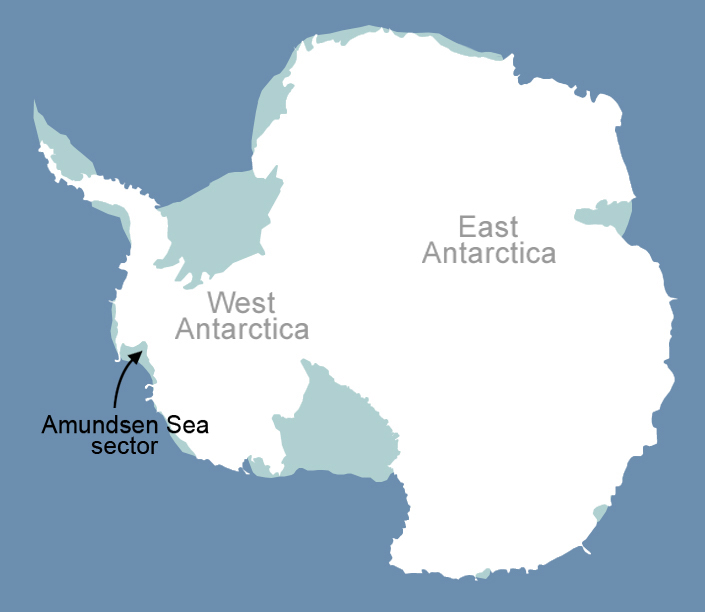Iceberg 4.5 Times the Size of Manhattan Breaks Off Antarctic Glacier
This story was updated Oct. 4, 2018 at 1:40 p.m. EDT.
A colossal iceberg four and a half times the size of Manhattan has broken off the Pine Island Glacier in West Antarctica, marking the second time the glacier has calved a giant iceberg in just two years, according to news reports.
On Saturday (Sept. 23), Stef Lhermitte, a satellite observation specialist at Delft University of Technology in the Netherlands, saw a satellite image showing that the glacier had lost an enormous chunk of ice. He posted the news on Twitter, saying, "Breaking news from Pine Island Glacier, which lost 267km2 [103 square miles] of icebergs today, after the internal crack resulted in a large calving event."
The event is a major one, said Peter Neff, a glaciologist and earth scientist at the University of Rochester in New York. "[It's] not unprecedented, but this glacier is concerning for future sea level rise," Neff posted on Twitter on Sunday. [Photo Gallery: Antarctica's Pine Island Glacier Cracks]
Of all the glaciers in West Antarctica, the Pine Island Glacier is the largest contributor of ice to the ocean. Each year, it loses 45 billion tons (40.8 billion metric tons) of ice, causing sea levels to increase 0.03 inches (1 millimeter) every eight years, according to The Washington Post. If the entire glacier melted, sea levels could rise 1.7 feet (0.5 m), The Washington Post reported.
The Pine Island Glacier has a long history of calving icebergs, but these events have been happening more frequently in recent times, said Seongsu Jeong, a postdoctoral researcher at the Byrd Polar and Climate Research Center at The Ohio State University.
Jeong noted that the glacier calved icebergs in January 2001, November 2007, December 2011, August 2015 and September 2017. "In terms of frequency, it's happening more than before," Jeong told Live Science.
Get the world’s most fascinating discoveries delivered straight to your inbox.
In a 2016 study published in the journal Geophysical Research Letters, Jeong and his colleagues found that the ocean beneath the edge of the glacier — that is, where the glacier borders Pine Island Bay — is warming the ice and causing it to crack.
In the past, the Pine Island Glacier has broken at one side, and that crack traveled to the other side, leading to a calved iceberg, Jeong said. However, he and his colleagues discovered that the nearly 225-square-mile (582 square km) iceberg that broke off in 2015 started nearly 20 miles (32 km) inland in 2013. This week's calving event also appears to have started in the middle of the glacier, Jeong said.
This "inside out" melting may be happening because human-caused climate change is warming the oceans, or because of increased ocean flow reaching the bottom of the ice shelf where the glacier rests, Jeong said.
These calving events have consequences, Jeong added. Icebergs float, so they won't cause sea levels to rise unless the water within them melts, he said. However, the edges of glaciers help keep the rest of the glacier from melting, like "debris clogging the drain," Jeong said. As these edges wear away, the rest of the glacier is more likely to melt into the ocean, he said.
"It’s generally accepted that it’s no longer a question of whether the West Antarctic Ice Sheet will melt, it’s a question of when," Ian Howat, an associate professor of earth sciences at Ohio State, who wrote the 2015 study with Jeong, said in a statement last year. "This kind of rifting behavior provides another mechanism for rapid retreat of these glaciers, adding to the probability that we may see significant collapse of West Antarctica in our lifetimes."
After separating from the glacier, the Pine Island iceberg broke apart into several more pieces, satellite images showed. "#Sentinel1 (23/9 vs. 21/9) shows the Pine Island glacier calving clearly and seems to indicate that the iceberg is falling in pieces 2/n," Lhermitte posted on Twitter.
The Pine Island Glacier isn't the only icy body that birthed a glacier this year. In July, the Larsen C ice shelf in Antarctica calved an iceberg the size of Delaware, Live Science previously reported.
Editor's Note: This story was updated to fix the metric conversion from 45 billion tons to 40.8 billion metric tons.
Original article on Live Science.

Laura is the archaeology and Life's Little Mysteries editor at Live Science. She also reports on general science, including paleontology. Her work has appeared in The New York Times, Scholastic, Popular Science and Spectrum, a site on autism research. She has won multiple awards from the Society of Professional Journalists and the Washington Newspaper Publishers Association for her reporting at a weekly newspaper near Seattle. Laura holds a bachelor's degree in English literature and psychology from Washington University in St. Louis and a master's degree in science writing from NYU.

